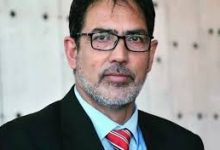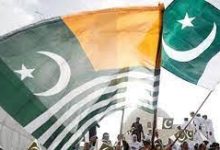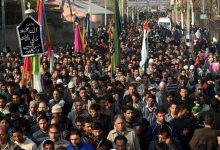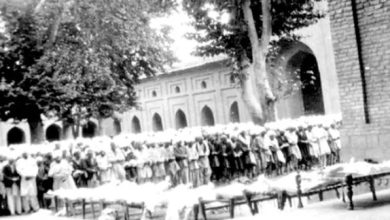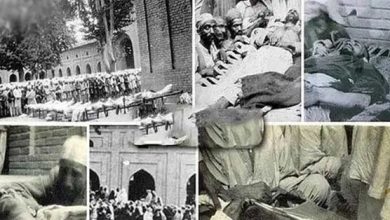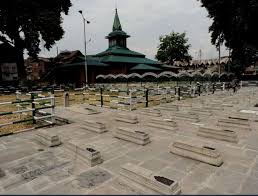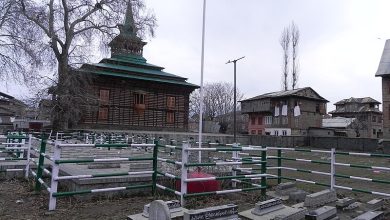Behind the facade of Modi’s ‘New Kashmir’
‘In Kashmir, the injustice and indifference of the Indian state is everywhere on full display’
 Rana Ayyub
Rana Ayyub
In early March, Indian Prime Minister Narendra Modi flew to the Srinagar airport in the capital of the Himalayan state of Kashmir and made his way by convoy to a 30,000-seat stadium close to the center of town. In front of crowds that had gathered on the stadium floor, he spoke emphatically of his efforts “to win your hearts,” echoing a sentiment he had expressed weeks earlier on a visit to Jammu. “Friends, Jammu and Kashmir is touching new heights of development because it is breathing freely now.”
The event at Bakshi Stadium was several weeks before India’s nearly one billion voters began casting ballots in nationwide elections. But Modi wasn’t in town to rally electoral support for his Bharatiya Janata Party. The party’s decision not to field any candidates in Kashmir, and instead rely on local proxy parties to do its bidding, reflected an acknowledgment of just how deep its unpopularity in the region remains.
Modi’s decision in 2019 to abrogate Article 370, which removed a longstanding constitutional guarantee of near autonomy for Jammu and Kashmir, made the Hindu nationalist BJP an object of powerful resentment in the Muslim-majority region. The move, he had promised at the time, would enable Kashmir to develop along with the rest of India and help Kashmiris experience the “freedoms” the other states and territories enjoy.
Neither happened, but that hasn’t stopped Modi from pushing a narrative that political and economic progress is arriving now that the “barrier” that was Article 370 has been removed. If there is residual anger at his move, Modi seems to say, it can only be from Kashmiris who are innately hostile to the Indian nation.
Weeks later, as voting got underway, residents of Jammu and Kashmir — historically ambivalent about the potential for elections to bring real change — recorded the highest voter turnout in more than three decades. In mainland India, the mainstream media, much of it allied to the BJP, spoke of the success of the Modi vision in deepening Kashmiris’ engagement in national politics. But as I toured Kashmir in the weeks leading up to the vote, I understood the size of this year’s turnout — the first elections since Article 370 was removed — to stem from something very different.
BJP Propaganda
I landed in Srinagar from Mumbai on April 25, not long before voting began. It had been four and a half years since my last visit to the state. In 2019, soon after the repeal of Article 370 was announced, I wrote a dispatch from Srinagar on the jailing of young children whom police had accused — often falsely — of taking part in protests against the removal of Kashmir’s special status. The report appeared in The Washington Post and it prompted outrage from Kashmiri state officials. On Twitter, often tagging Modi’s account, and in articles, BJP leaders and their supporters asked why I hadn’t been arrested for tarnishing the image of Kashmir, the Himalayan idyll where, so the BJP argued, citizens were about to realize the gains of their state’s forced integration into India proper.
At Srinagar airport this time around, I was greeted by posters of films from decades ago that offered enticing visions of the region’s beauty. One shows Amitabh Bachchan, a longtime Bollywood icon, romancing his heroine in a tulip garden — an appetizer for the thousands upon thousands of tourists from across India who visit the state each spring for its famed tulip season. Other images showed the shikara, the iconic wooden boat that takes visitors along the Jhelum River through Srinagar’s Old Town, and out into the mountain-ringed Dal Lake. None showed the checkpoints, the groups of soldiers and paramilitaries that wait at street corners, the convoys of military trucks that thunder along mountain passes near the border with Pakistan. That all comes once you leave the airport. Kashmir remains among the most militarized regions in the world, and the “freedom” Modi spoke of at Bakshi Stadium is — to my eyes at least — nowhere to be seen. It is all just as it was in 2019: The injustice and indifference of the Indian state is everywhere on full display.
In February, I spent an evening at a cinema near where I live in Mumbai. The film we were there to see was “Article 370,” a fictionalized espionage thriller (along the lines of “Zero Dark Thirty”) about the removal of Kashmir’s special status; it has become one of the highest-grossing films of the year. Actor Arun Govil, who became a household name for his portrayal of Lord Ram in a wildly popular television series called “Ramayan” in the 1980s and 90s, plays a character loosely based on Modi, portrayed in the film as the brainchild behind the “liberation” of Kashmir from a culture of terror.
There are no gray areas or nuances in the film; Kashmiri civilians are portrayed as radicals who receive funding from Pakistan to unleash a jihadi agenda to destabilize Hindu India. Human rights activists are projected as enablers also receiving support from terror outfits as a part of a nefarious anti-India agenda. Kashmiri ministers from the two mainstream political parties are derided and treated with contempt; activists from the state are caricatured as anti-national elements. Evil, gun-toting, kohl-eyed Muslims flying Pakistani flags are placed in contrast with the prime minister, who is in grief watching the dead bodies of Indian soldiers and then takes it upon himself to execute the master plan of liberating Kashmir from a dangerous ideology.
When I saw the film, the Islamophobic subtext drew cheers and whistles from the audience. Each time Govil appeared on the screen, “Bharat Mata ki jai” (“Glory to India”) chants in the theater got louder. Govil, representing the BJP, ran for and won a seat in parliament in the northern state of Uttar Pradesh; he liked to invoke Hindu pride at his election rallies. Such was the nationwide religious fervor associated with “Ramayan” that many Indians, especially in the rural parts of the country, worshipped Govil’s image — an incarnate of Lord Ram, or Rama, one of Hinduism’s major deities.
Choosing Govil to play the role of the prime minister in “Article 370,” then, was not an accident. The co-writer of the film also wrote and directed another blockbuster, “Uri: The Surgical Strike,” a soft propaganda military action film that arrived in theaters just before the 2019 general elections in India. Likewise, “Article 370” was released within only a couple of months before the 2024 election.
This was not the first time Kashmir has been fetishized in Indian cinema as a part of a right-wing narrative. 2022’s blockbuster “The Kashmir Files” contained almost every imaginable Islamophobic trope, demonizing not just average Kashmiris as gun-wielding jihadists but, along with the rest of India’s 200 million or so Muslims, as ungrateful and unpatriotic, living off subsidies while harboring loyalty to Pakistan. The men in these films wear skull caps, kohl smeared on their eyes, lusting for Hindu blood and women. Both films were endorsed by Modi and ministers in his cabinet, and the government waived taxes on tickets to entice more people to theaters.
The BJP has been stunningly successful at pressing popular media into the service of its Hindu-first agenda. Over the last few years, Bollywood has churned out blockbusters denigrating Indian Muslims, justifying the majoritarian politics that seeks to exclude them and blame them for being a roadblock in the India growth story. Muslims in these films are portrayed as unemployed, backward terrorists bent on the destruction of the country, the enemy of the true nation, termites that need to be tamed and shown their place.
In part thanks to such propaganda, the Modi regime has been able to manipulate, again with huge success, the view that many Indians have of Kashmir and its citizens. Hindu nationalists have long viewed Kashmir as an affront to their imagined Akhand Bharat, a century-old right-wing doctrine similar to Vladimir Putin’s expansionist vision of the Russian nation. Through that lens, Kashmiris are considered innately violent, using and abusing their autonomy to attack the Indian nation and its democratic institutions.
Modi’s decision in 2019 to bring the state under the direct control of New Delhi is therefore portrayed as an act of benevolence, if not salvation. And with Indians from the mainland now able to buy land and set up businesses — something an extension of Article 370, Article 35A, had denied them — southern wealth will surely come pouring north.
Life Under Constant Surveillance
April is peak tourism season in Kashmir; at my guesthouse in Srinagar, I encountered a group of tourists mostly from the western state of Maharashtra taking instructions for the day from their tour guide. One man bearing the Indian flag asked if he could plant it at Lal Chowk — the square in the center of town and long a symbol of resistance for Kashmiris. Since 2019, though, the famed clocktower there has been periodically lit up in the red, green and orange of the Indian flag. The rest of the group chanted “Bharat Mata ki jai.”
I told a local shopkeeper at Lal Chowk about seeing this scene. “They are trying to rub salt on our wounds by bringing in people from outside to take away our jobs, our land,” he shot back at me. Echoing a popular belief that the BJP is seeking to engineer a demographic shift in the Muslim-majority state by allowing mainland Indians to invest in property, he added: “They never wanted the people of Kashmir [to join India]; they wanted this piece of land to occupy.”
On my way to the Mumbai airport for the flight to Srinagar, massive billboards were on view hailing Modi for Article 370. One labeled him “The man who achieved the impossible” and had an image of Dal Lake in the background.
Much of the mainstream media in India is captured by the Hindu right, and likewise Kashmiri independent media outlets are mostly silenced. I have worked as a journalist since 2006, reporting on the abuses of state power in India under the BJP and the explosions of communal violence its leadership has instigated. I have experienced sustained harassment and threats from the authorities, and my articles have been held up by BJP officials as emblematic of anti-state propaganda. I have also been subjected to vile campaigns of abuse by pro-BJP Hindu nationalists on Twitter and been served dozens of defamation notices and summonses from the authorities, and currently I am facing two trials related to my work. But I still see myself as privileged compared to many Kashmiri journalists. Life for them is qualitatively different than in mainland India.
Several days into my visit, I traveled by car to Shahgund, 22 miles northwest from Srinagar, to meet the family of Sajad Gul. In October 2021, Gul — a freelance reporter who often worked with the news website The Kashmir Walla — told The Diplomat that he was experiencing persistent anxiety following a recent police raid on his home. Gul had earlier written a story about a boy killed by police who had been accused of being a militant, a charge the boy’s family contested. Now Gul was lying awake at night, fearing another raid.
In January the following year, the police arrived late at night. Gul’s brother told me that so heavy was the security presence outside the house that evening — soldiers, army trucks waiting on the road — that it seemed like they were expecting a fight. Gul was detained and charged under the Jammu and Kashmir Public Safety Act. Two and a half years on, he remains in jail.
It took two hours to get to Shahgund; we passed by tourists who stood at the roadside taking selfies with army officials. I’d asked the local journalist friend accompanying me whether we would likely be under surveillance. “Do you still doubt it?” he replied mockingly. Within a short time, we were stopped by army officials who asked us about the purpose of the visit, eyed our ID cards, checked our bags. Several miles up the road, we were stopped again. “Welcome to a routine we have lived our entire lives,” another friend remarked at dinner that evening.
This wasn’t my first such experience with Kashmir’s security state: After I met with victims of police shootings while helping report a story for The New Yorker in 2019, intelligence officials intercepted and interrogated me and a colleague. During a subsequent visit, a friend at a news agency called to say that he had heard rumors that I would be arrested and encouraged me to flee.
Every journalist I spoke to over the course of five days in Kashmir has experienced some form of intimidation, if not worse, by police. So relentless is the harassment from so-called “CID calls” — the late-night phone calls from the Central Intelligence Department that Gul so feared and ultimately fell victim to — that many have quit the profession. Others have hung on but at great personal cost, enduring travel bans, imprisonment or exile from India altogether. Just two of the 20 or so I talked to for this story agreed to be quoted on the record.
One of them is Aakash Hassan, a 27-year-old journalist who regularly reports for the Guardian. In 2022, police stopped him from boarding a flight to Sri Lanka. In a series of tweets afterward, he described how they forced him to wait in a detention room while his bags were unloaded from the plane. “After making me wait for five hours, without providing even water to drink,” he wrote, “I have been handed over my passport and boarding pass with a red rejection stamp: ‘Cancelled Without Prejudice.’” All his subsequent attempts to leave India have failed, and opportunities for international fellowships have been missed. During a recent attempt to visit Nepal, immigration officials told him that his passport was under scrutiny, and he was blocked.
Hassan told me that police have questioned him, his family, his neighbors, the elders in Fatehpora, his village in southern Anantnag, and others because of his “activities.” A technology reporter, he covered the months-long internet blackout that followed the abrogation of Article 370 in 2019, as New Delhi sought to squash street protests and prevent citizen journalists from posting news of protests. In the weeks after the new status was enacted, minors were detained, the army was freely attacking civilians — and the Ministry of Home Affairs branded Hassan’s reportage mere propaganda.
As a youth traveling outside of Kashmir, he recalled, “I used to be enamored by the normalcy that the rest of India provided; that I could sit at a dhaba [food joint] and if a police official or an army man walked in, I did not have to break into a sweat.” He entered journalism reading the works of lauded Kashmiri journalists and writers, hoping to later emulate them. He would watch his family gather to listen to BBC Radio and imagined one day becoming a voice who could be heard by other Kashmiris.
Others have suffered an especially cruel form of psychological torment. Asif Sultan returned to his family home in Srinagar in February this year after five years in prison, and only hours later he was rearrested and sent back to jail. Thirty years old at the time of his first arrest, Sultan had been sentenced in 2018 under an anti-terror law, the Unlawful Activities Prevention Act. Police claimed he had sheltered insurgents; his colleagues believe the sentencing stemmed from an article he wrote about the Kashmiri militant Burhan Wani. His rearrest, this time apparently related to a riot that took place in a Srinagar prison during his stint there in 2019, shocked his friends and family members; a judge would later accuse the police of holding him “without any reasonable justification” and called him a “law-abiding citizen” with a “high social status and esteemed reputation in society.”
Intimidated, But Not Silent
Election time in India is especially fraught for independent journalists. The country ranks 159 — below Libya, Somalia, Pakistan and Venezuela, and only three spots higher than Russia — in Reporters Without Borders’s World Press Freedom Index. “With violence against journalists, highly concentrated media ownership, and political alignment, press freedom is in crisis in ‘the world’s largest democracy,’” reads RSF’s description of India’s media landscape.
Some of the most critical work about Modi and the Hindu right has been written by independent journalists, web publications and YouTubers, which says a lot about the mainstream newspapers and television programs. Modi, now having won a third term in office, has not held a single genuine press conference in his 10 years in power. Raids and arrests of journalists under terror charges have stepped up in the last year in particular; publications like NewsClick, an independent news website, are being raided, their reporters and editors arrested for alleged anti-India activity.
So precarious has life become for Kashmiri journalists since 2019 that some have been driven into exile. From his home in Washington, Raqib Hameed Naik runs Hindutva Watch, a website that tracks hate crimes against minorities and which has been instrumental in documenting hate speech against Muslims in particular. In January this year, X — formerly Twitter — blocked the website’s account after a legal request from the Indian government.
Naik left Kashmir in August 2020. A year before, he had written a piece for The Globe Post on the sweeping lockdown that followed the termination of Article 370. Afterward, he was awoken in the night by a loud banging on his door; later came phone calls from various state officials. He was questioned about his sources of income and asked why he insisted on writing for foreign publications. He fled. I asked him over the phone what stopped him from returning. He said he could not be sure that his freedom of movement and expression would not be curbed.
When journalists from cosmopolitan India are jailed, they often find solidarity, sympathy and much-needed coverage in the national mainstream and international press. Journalists in Kashmir do not usually receive the same level of attention. But nor do they seek it; in a state with a long history of the state punishing the families of perceived enemies, silence is perhaps the only way to protect kin.
For their part, Kashmiris often sneer at Indian mainstream media for normalizing their trauma and for viewing the Kashmiri population as ungrateful, if not deserving of their misery. As the internet blackout and lockdown began in 2019, mainstream news anchors from Delhi were mocked for photographing themselves holding the famed Kashmiri apple against the backdrop of the Jehlum River, all while people in their thousands were being detained and the entire region was placed under siege. At an election rally I attended in Mangzam, 30 miles south of Srinagar, Ahmed Peer, a local businessman, said to me: “Our lands are being taken from us, our sovereignty, our self-respect has been snatched from us, and you guys will show tourists at Dal Lake as a symbol of our alleged prosperity.”
The Myth Of ‘New Kashmir’
“They are everywhere,” Wali Mohammad said of the paramilitary soldiers standing guard in a quiet lane near his house in the Ali Kadal neighborhood of Srinagar. Wali is a shoemaker; his son, Momin, has spent the past five years in prison in Bareilly, in Uttar Pradesh, where hundreds of Kashmiri young people have been detained on various spurious accusations in the wake of the abrogation of Article 370.
Momin was a teenager when was arrested in 2019 for his alleged involvement in the killing of a police sub-inspector. Police claimed that the student who allegedly killed the policeman studied with Momin, and that Momin had been among a group of friends who planned the murder. “He was sleeping by his mother’s side,” Wali says of the night police came for him. “They dragged him out of our house. There were other young kids too at the police station — they all looked terrified.”
In Wali’s version of events, Momin had been in town buying tea when the officer was killed. The entire neighborhood, as well as Momin’s school friends, could provide alibis. After his arrest, Wali visited him, and Momin spoke of his fear at being moved elsewhere. “It is scary here, please take me back home,” Wali recalled him saying. “Do not leave me here, they are saying they will take us out of Kashmir.”
“Everyone said, ‘Do not apply for bail,’” Wali told me. “If you do, they will slap terror charges against him and rearrest him. I refused to listen to them, [and] my worst fears came true.” As soon as he turned 18, the police picked Momin up again. Presented before the magistrate, the investigators alleged they had reasons to believe that Momin was encouraging anti-national and extremist activities in Kashmir.
The investigating agency has not been able to provide a single piece of evidence of Momin’s involvement in the murder of the police officer, Altaf Khan, a human rights lawyer representing Momin, told me. Momin is just one of thousands of Kashmiris in jails across the country with no access to the ordinary legal resources citizens of a democracy would be accustomed to, Khan said. Khan himself has been at the receiving end of state surveillance and has watched fellow human rights lawyers experiencing police raids; Modi’s “New Kashmir” — Naya Kashmir — he went on, is a myth, a fictitious facade where images of an idyllic paradise mask a violent police state ripping apart communities of innocent civilians.
At the time of writing, election results in India are rolling in. Agha Ruhulla Mehdi and Mian Altaf Ahmad, both from the National Conference and vocal critics of the Modi government, have won decisive victories in Kashmir. The most symbolic victory in the election was Abdul Rashid Sheikh’s — Engineer Rashid, as he is widely known — who won the constituency of North Kashmir despite being confined to Tihar Jail since 2019. He likely won’t be released to represent his people in parliament. Nevertheless, Kashmiris clearly voted in mass numbers to elect a leader whose plight is the same as so many there — he is one of them, an enemy of the state.
In Kashmir, like in the rest of India, Modi’s Hindu nationalist politics seem to have received a major setback, despite him winning a third term. In an election where hate speech against Muslims was normalized straight from the prime minister’s office, in an election that was fought around the cult of Modi, a reduced majority is an indication that the prime minister’s hubris had been punctured.
A Dent In Modi’s Image
It was, of course, predictable that Modi and Home Minister Amit Shah would twist the record voter turnout in Kashmir in April into a form of self-flattery. It will be the version of events that prevails across India long after the election results come in, such is the dominance of the BJP machinery over all forms of media — even, it seems, the likes of Elon Musk’s X.
On May 29, NDTV, one of the biggest news broadcasters in India now run by longtime Modi friend and billionaire Gautam Adani (who was recently accused of the “largest con in Indian corporate history”) played an exclusive interview with Shah. In the interview, Shah claimed that Kashmir has been one of the biggest successes of the Modi government and a prestige project of the Modi regime, claims that went unchallenged. The recorded interview is repeatedly broadcast throughout the day and amplified across social media, making Modi out to be the conductor of yet another master political stroke.
June’s fractured election result might still give the BJP the image of a successful political party, despite India’s massive unemployment, rural distress and frustration over politics in many parts of the country. But that image has taken a blow. One of the most embarrassing defeats for Modi in this election was losing the Faizabad constituency in Uttar Pradesh, home to the grand Ram Mandir temple complex, which Modi personally inaugurated in January this year. The Ram Mandir was constructed over the demolished Babri Mosque, a pet project of Modi’s and the Hindu nationalist right-wing. The constituency is at least 70% Hindu, and Modi still lost; in Uttar Pradesh in general, the BJP won only around half the seats it previously had.
For many Kashmiris intimately familiar with the perils of defying the state through protest or other forms of opposition, any outright displays of dissent are dangerous. Voting for Kashmiri parties like the National Conference and the People’s Democratic Party, or independent candidates like Engineer Rashid, was the only safe way to make their voices heard, the only vent for their anger still available to them. “Nothing is fair here,” Nasim Rashid, an apple trader, told me. “But this is the only outlet we have — this is our only hope. We want to give a fitting response to the betrayal of the Indian state.”
At the Srinagar airport, I strolled around at a bookshop before I boarded my flight back to Mumbai. Multiple biographies of Narendra Modi adorned the bookshelves. I asked for books by Kashmiri writers — Mirza Waheed, Basharat Peer, Agha Shahid Ali. The store manager laughed. “We cannot keep them anymore.”
Note: Rana Ayyub is an Indian journalist and opinion columnist with The Washington Post.






